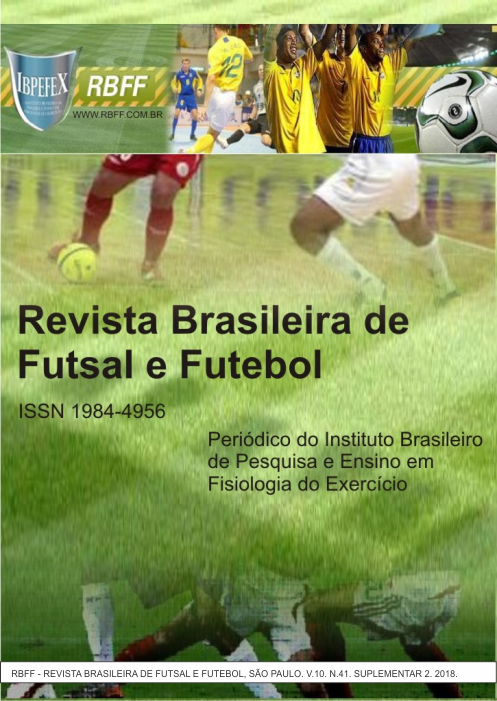Temporary incidence of gols in the World Cup of 2018
Abstract
Football is a sport characterized by continuous and intermittent actions. Their matches have regular and predictable actions, however during a match the occurrence of unpredictable events can influence the final outcome of the game. Undoubtedly, the goal is the most important variable of a football game, being relevant the knowledge about its incidence throughout a game. The objective of the study was to analyze temporarily the incidence of goals in the world cup of 2018. For this it was realized an analysis of all the goals occurred in the 64 games of the competition, through the application 365 scores. The results show that most of the goals (N = 100) occurred in the second half of the matches, more specifically in the last period of play, between minutes 76 to 90 (N = 37). In this way it can be concluded that a difference was found in the temporal incidence of the goals in the 2018 world cup, inasmuch as there was a higher occurrence of goals in the second stage of the games, and in the final period of the game when compared to others. Thus, the technical committees of the teams must be attentive to this fact, seeking to carry out a planning that contemplates questions such as physical, technical, tactical and psychological preparation of the athletes, seeking to prepare them to maintain a level of attention and concentration even greater in this period of the games, since, the studies realized in respect have shown this tendency.
References
-Armatas, V.; Yiannakos, A. Analysis and evaluation of goals scored in 2006 World Cup. Journal of Sport and Health Research. Greece. Vol. 2. Num. 2. 2010 p. 119-128.
-Armatas, V.; Yiannakos, A.; Sileloglou, P. Relationship between time and goal scoring in soccer games: Analysis of three World Cups. International Journal of Performance Analysis in Sport. Greece. Vol. 7. Num. 2. 2007. p. 48-58.
-Cunha, S.A.; Binotto, M.R.; Barros, R.M.L. Análise da variabilidade na medição de posicionamento tático no futebol. Revista Paulista de Educação Física. São Paulo. Vol. 15. 2001. p. 111-116.
-Di Salvo, V.; e colaboradores. Performance characteristics according to playing position in elite soccer. International Journal of Sports Medicine. New York. Vol. 28. Num. 3. 2007. p. 222-227.
-Di Salvo, V.; e colaboradores. Analysis of high intensity activity in premier league soccer. International Journal of Sports Medicine. New York. Vol. 30. Num. 3. 2009. p. 205-212.
-Marcelino, R.; Sampaio, J. Investigação em Ciências do Desporto: dos testes de hipótese nula à necessidade de interpretações com significância prática e/ou clínica. Sociedade Portuguesa de Estatística. Boletim SPE. 2015. p. 28-35.
-Marques Junior, N.K. Evidências científicas sobre o gol do futebol: Uma revisão sistemática. Revista Brasileira de Futsal e Futebol. Vol. 7. Num. 25. 2015. p. 297-326. Disponível em: <http://www.rbff.com.br/index.php/rbff/article/view/342>
-Mascara, D.I.; Calicchio, L.; Chimina, J.G.C.; Navarro, A.C. Análise da incidência de gols no campeonato Paulista 2009: Série A1, A2 e A3. Revista Brasileira de Futsal e Futebol. Vol. 2. Num. 4. 2010. p. 42-46. Disponível em: <http://www.rbff.com.br/index.php/rbff/article/view/41>
-Rampinini, E.; e colaboradores. Technical performance during soccer matches of the Italian Serie A league: effect of fatigue and competitive level. Journal of science and medicine in Sport/Sports Medicine. Australia. Camberra. Vol. 12. Num. 1. 2007. p. 227-233.
-Santos, T.C.B. A incidência de gols na fase classificatória para a Copa do Mundo de2010 na África do Sul. Revista Brasileira de Futsal e Futebol. Vol. 7. Num. 23. 2015. p. 67-71.
-Silva, C.D. Fadiga: evidências nas ocorrências de gols no futebol internacional de elite. Lecturas Educación Física y Deportes. Buenos Aires. 2006.
-Silva, C.D. Gols: uma avaliação no tempo de ocorrência no futebol internacional de elite. Lecturas Educación Física y Deportes. Buenos Aires. Vol. 112. 2007. p. 1-7. Disponível em: <http://www.efdeportes.com/efd112/gols-uma-avaliacao-no-tempo-de-ocorrencia-no-futbol. htm>. Acesso em: 3 jul. 2018.
-Silva, C.D.; Campos Júnior, R.M. Análise dos gols ocorridos na 18ª Copa do Mundo de futebol da Alemanha 2006. Lecturas Educación Física y Deportes. Buenos Aires. Vol. 101. 2006. p. 1-8.
-Souza, E.L.N.; Farah, B.Q.; Dias, R.M.R. Tempo de incidência dos gols no Campeonato Brasileiro de Futebol 2008. Revista Brasileira de Ciências do Esporte. Vol. 34. Num. 2. 2011. p. 421-431.
-Thomas, J.R.; Nelson, J.K.; Silverman, S.J. Métodos de pesquisa em atividade física. Porto Alegre. Artmed. 2012.
-Zacarias, F.; Silva, A.S.; Olivas, M.A. Incidência de gols nas partidas de futebol de salão nos jogos escolares de Minas Gerais no módulo I da fase de Itajubá. Revista Brasileira de Futsal e Futebol. Vol. 7. Num. 23. 2015. p. 21-24. Disponível em: <http://www.rbff.com.br/index.php/rbff/article/view/310/255>
Authors who publish in this journal agree to the following terms:
- Authors retain the copyright and grant the journal the right of first publication, with work simultaneously licensed under the Creative Commons Attribution License BY-NC which allows the sharing of the work with acknowledgment of the authorship of the work and initial publication in this journal.
- Authors are authorized to enter into additional contracts separately for non-exclusive distribution of the version of the work published in this journal (eg, publishing in institutional repository or book chapter), with acknowledgment of authorship and initial publication in this journal.
- Authors are allowed and encouraged to post and distribute their work online (eg, in institutional repositories or on their personal page) at any point before or during the editorial process, as this can bring about productive change as well as increase impact and impact. citation of published work (See The Effect of Free Access).





